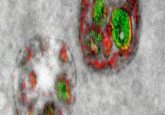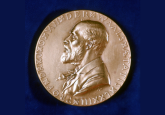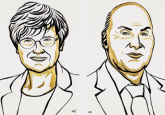Who won the 2021 Nobel Prize in Chemistry?

Until the year 2000, chemical reactions could only be catalyzed using metal compounds or enzymes. Then, thanks to the research of Benjamin List and David W. C. MacMillan, this changed.
Benjamin List (Max-Planck-Institut für Kohlenforschung, Mülheim an der Ruhr, Germany) and David W. C. MacMillan (Princeton University, NJ, USA) have been jointly awarded the 2021 Nobel Prize in Chemistry for the development of asymmetric organocatalysis.
Described by the Nobel committee as an “ingenious tool for building molecules,” asymmetric organocatalysis has revolutionized drug discovery and enabled chemical reactions to occur more precisely, cheaply, quickly and greenly.
The research they independently published in 2000 demonstrated that small organic molecules can be used to catalyze chemical reactions and achieve product specificity when chirality is a consideration.
Mirrored molecules
Chiral molecules are those which cannot superimpose their mirror images onto each other, like a pair of hands. One example is limonene, which exists as two molecules that are mirror images of each other – or enantiomers. One of limonene’s enantiomer’s smells like oranges, while the other smells like lemons.
 Who won the 2021 Nobel Prize in Physiology or Medicine?
Who won the 2021 Nobel Prize in Physiology or Medicine?
Touch has topped the biomedical research charts, delivering the 2021 Nobel Prize in Physiology or Medicine into the hands of the two researchers who identified the receptors for temperature and pressure.
Chirality is an important consideration in drug development, where drug compounds with different enantiomers can interact with the body in different (and potentially dangerous) ways. Thalidomide, which was used to treat morning sickness in the 1950/60s, is an infamous example of this. While one of its enantiomers has a sedative effect, the other causes fetal abnormalities when ingested by pregnant women.
In contrast to this, enantiomers can also work together to prevent serious side effects, as was the case with Eli Lilly’s Prozac. Eli Lilly held the patent for fluoxetine (Prozac). In the mid-90s, Sepracor obtained patents to separate fluoxetine into its two enantiomers and market these individually as medications for migraine and depression. Together, Eli Lilly and Sepracor agreed to develop one of the enantiomers, (R)-fluoxetine, as a side-effect-free version of Prozac.
However, serious side effects were observed at high doses in clinical trials that were not seen with the original Prozac, which contained both isomers of fluoxetine. Eli Lilly then abandoned the drug development, costing millions of dollars.
Solving an unknown problem
MacMillan had been working on improving asymmetric catalysis using metals at Harvard University (MA, USA), however, he realized that many metal catalysts that had been developed in the lab were rarely translated for use in industrial applications. He attributed this to metal catalysts being too difficult and expensive to use due to their frequent requirements for oxygen- and moisture-free conditions for use. When he moved to UC Berkeley (CA, USA), he knew he would need a different approach if catalysts he developed would be used as intended by industry, thus, he began work with organic compounds, which he demonstrated worked very well as asymmetric catalysts.
Meanwhile, in the same US state at the time, List had been working with catalytic antibodies at the Scripps Research Institute (CA, USA). He began to wonder if an entire enzyme was actually required to catalyze a reaction, or if a single amino acid would be able to achieve the same feat. In the early 1970s, a study had shown that proline could be used as a catalyst, however, this research was never followed up on. Assuming there must be a reason why this had never been pursued, List attempted to use proline to catalyze an aldol reaction with no expectations for any real outcome. To his surprise, it was incredibly effective and he also further discovered that proline worked as an asymmetric catalyst as well.
When announcing the winners of the Nobel Prize in Chemistry, the Committee commented that many will have questioned why no one thought of making catalysis simpler any sooner. The answer – they believe – is that “simple ideas are often the most difficult to imagine.” It was a long-held and accepted view that only metals or enzymes could catalyze chemical reactions, so it took two scientists who could look beyond pre-conceived beliefs, strip science back to its most basic form and solve a problem.
MacMillan explained he was “Dazed, confused, elated, proud, sentimental, weepy,” when he found out the news that he had won the 2021 Nobel Prize in Chemistry, while List “thought it was a joke.”





